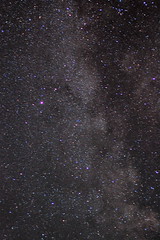Nightfall
 My interest in astronomy has been lifelong, though varying in intensity over the years, but I only saw the Milky Way for the first time a couple of months ago. It was an epiphanic moment akin to the ending of Isaac Asimov’s classic short story, “Nightfall,” in which a civilization sees the stars for the first time in millenia. Knowing that it’s there in theory is one thing; seeing it for yourself is quite another.
My interest in astronomy has been lifelong, though varying in intensity over the years, but I only saw the Milky Way for the first time a couple of months ago. It was an epiphanic moment akin to the ending of Isaac Asimov’s classic short story, “Nightfall,” in which a civilization sees the stars for the first time in millenia. Knowing that it’s there in theory is one thing; seeing it for yourself is quite another.
My earliest observation was the 1979 solar eclipse, which I saw from my front porch in Winnipeg, but most of my astronomy, growing up, was theoretical rather than observational. In other words, I read a lot of books. Family finances precluded me from ever owning a telescope (especially in the early 1980s), so all my childhood observations were naked-eye views from my backyard, usually in winter (so that I was awake when it was dark). Because it was a suburban sky, and with considerable light reflected from the snow, I didn’t see much. Nor did I necessarily appreciate how much I wasn’t seeing. Milky Way? Forget about it: sky conditions were so poor that I couldn’t even see the Little Dipper.
A lot could be said about light pollution; in fact, a lot has: this New Yorker article from last August is as good an introduction to the subject as any (via Kottke). Modern, urban populations don’t appreciate how washed-out their skies have become, and how little they can see — but, to be sure, the value of being able to observe the Sagittarius Arm of the Milky Way has not yet been quantified. Though awareness of the problem is growing, the problem itself is, too: the University of Toronto’s David Dunlop Observatory is closing, a victim of urban sprawl and its concomitant light pollution (via Richard).
(More light pollution links: the International Dark-Sky Association; Bortle’s Dark Sky Scale; Light Pollution and Observing Sites on Jerry Lodriguss’s astrophotography site; a page about light pollution in the U.S.; a page about light pollution around the world with a focus on Europe. There are maps.)
 According to the light-pollution maps, Shawville isn’t the greatest location, but it is quite literally several magnitudes better than my suburban vantage point in Winnipeg was. Once away from street and porch lights, the sky isn’t bad at all. During a new moon, I have seen the Sagittarius Arm of the Milky Way from my back porch. And whereas Polaris itself (by no means dim at magnitude 2.0) was not very bright in my young observations, I have now seen the complete Little Dipper with the naked eye, the dimmest star of which, Eta Ursae Minoris, is a magnitude 4.95 star. I’m certain I’ve seen fainter stars; I just can’t identify them (yet). As a dark sky site the middle of town leaves a lot to be desired, but it’s one hell of an improvement in my experience.
According to the light-pollution maps, Shawville isn’t the greatest location, but it is quite literally several magnitudes better than my suburban vantage point in Winnipeg was. Once away from street and porch lights, the sky isn’t bad at all. During a new moon, I have seen the Sagittarius Arm of the Milky Way from my back porch. And whereas Polaris itself (by no means dim at magnitude 2.0) was not very bright in my young observations, I have now seen the complete Little Dipper with the naked eye, the dimmest star of which, Eta Ursae Minoris, is a magnitude 4.95 star. I’m certain I’ve seen fainter stars; I just can’t identify them (yet). As a dark sky site the middle of town leaves a lot to be desired, but it’s one hell of an improvement in my experience.
So astronomy is back on the menu, now that it’s possible: it’s another advantage of living in the country. Because we’re in town and do not actually own a back yard, per se — our back lane is too well-lit and too obstructed by nearby buildings — we’ve had to work to find an observing site that was far enough away from ambient nighttime lights. Fortunately, that was solved with some polite questions; permissions to use land have been granted.
Now all that’s required is a telescope. More on that in a future post.